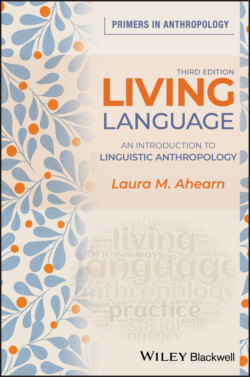Читать книгу Living Language - Laura M. Ahearn - Страница 28
Multifunctionality
ОглавлениеIn the mainstream view of language that is very common in the United States, language is thought to be a way to report events or to label objects or concepts. (Views of the main purpose of language can be quite different elsewhere in the world, as Michelle Rosaldo [Rosaldo, 1982] demonstrated.) Language is much more than reporting or labeling, however – people accomplish many things with words. Linguistic anthropologists use the term “multifunctional” to refer to all the different kinds of work that language does. One of the first scholars to analyze the various functions of language was Roman Jakobson, a Russian linguist who helped form what became known as the “Prague School” of linguistic theory. Jakobson (1960) identifies six “constitutive factors” in any speech event, and then attaches a corresponding function to each of these constitutive factors. All functions are always present in each speech event, Jakobson argues but, in certain cases, one function may predominate over the others. Figure 1.4 is a slightly modified version of Jakobson’s own model (1960:150, 154).
Figure 1.4 Jakobson’s model of the multifunctionality of language.
Source: Thomas A. Sebeok, Style in Language, pp. 150, 154, 350–377, © 1960 Massachusetts Institute of Technology, by permission of The MIT Press.
The main point to emphasize in this approach to language is that what many people consider to be the main purpose of language – to communicate information – is only one of six separate functions in Jakobson’s model. He calls this function the “referential” function, and while it is sometimes important in a linguistic interaction, there are many times when other functions predominate. Consider the following hypothetical example:
Your best friend hears that you have just received upsetting news, so she immediately sends you a text that says: “So sorry that I can’t even find the words to tell you.” While the text message conveys some information, and therefore has a referential function, according to Jakobson’s model, the message would probably best be interpreted as being predominantly oriented toward the speaker’s emotions (expressive function) as well as toward the addressee (conative function). The alliteration and the multimodality of the emoticon are examples of the poetic function that Jakobson believed was present even in the most mundane of interactions. By reaching out to you in order to reinforce the channel that connects you socially, your friend also activated the phatic function of language. And the “language about language” aspect of the message could be said to be an example of Jakobson’s metalinguistic function
(what linguistic anthropologists call metapragmatic discourse [Silverstein 1993; cf. Agha 2007; Lucy 1993]).
So, as this example demonstrates, even the simplest spoken and written linguistic interactions are multifunctional. Language accomplishes much more than simply referring to or labeling items or events. Through language, people convey nuanced emotions, display or hide judgmental attitudes about others, reinforce or sever social bonds, and talk about language itself. It is to this latter function of language that we now turn.
Figure 1.5 Cartoon playing off the language ideology that considers French a romantic language.
Grosz, Chris/Cartoon Stock.
